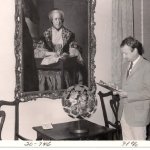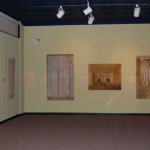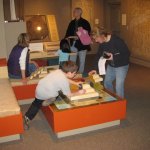
Meg Salocks
Arts Ed in Museum Spaces: The Rebirth of the Fitchburg Art Museum
Posted by Feb 13, 2015 0 comments

Meg Salocks

The Fitchburg Art Museum (FAM), located in Central Massachusetts, is an interesting example of a small community museum founded for a very different local population than the one in which it finds itself today. This has led to an even more interesting fold of arts education within their walls, as you’re about to find out!
The FAM was originally founded by Fitchburg native and painter, Eleanor Norcross, in 1929 to share her collections of European, Egyptian, and ancient art with local middle class families. Today, the local population is approximately 40% Hispanic, as well as Laotian, Mung, and Cambodian. The Fitchburg Art Museum must not only appeal to this varied population that is so different from its founding environment, but also to a significantly different base of older families and private schools that also consider the greater Central Massachusetts area home; a tricky task for any small institution.
 Old Fitchburg Museum. Image Source: Fitchburg Art Museum Facebook
Old Fitchburg Museum. Image Source: Fitchburg Art Museum Facebook
 Old Fitchburg Museum. Image Source: Fitchburg Art Museum Facebook
Old Fitchburg Museum. Image Source: Fitchburg Art Museum Facebook
Several years ago, the Fitchburg Art Museum faced an important moment of leadership turnover that forced them to confront the fact that the museum was in trouble – with few visitors, a diminishing budget, and a stagnant collection – in a neighborhood it hardly recognized anymore.
Under the helm of a new director, the museum has repositioned itself to become the “best community museum in the country” by directly engaging and working with their neighbors – families, students, schools, businesses, artists, and more. This has resulted in many different actions and programs, ranging from an Artists Town Meeting, to hiring bilingual tour guides, to a streamlined education department. The FAM is a relatively small museum with a limited staff and budget; their means of contributing to the overall education of their local students and neighbors has understandably been geared around finding the most efficient, least time- or money-consuming mode that still lets them engage with their community through their collections.
An Education Extension
While the Fitchburg Art Museum sees an equal importance in school partnerships as our other three museums featured in this series, they balance this value with their limited operational means by instead positioning themselves as an “extension” available to any and all schools in the area. So what does this entail?
Step 1: Identify the largest audience group. Because the Fitchburg has a unique mixture of historical pieces and exhibits on ancient Egypt, Greece, and Africa, along with a large collection of photography, painting, and local contemporary art, it serves as an easy resource for public schools in central Massachusetts who do not have the budget to shuttle students into Boston for a day to go to the Museum of Fine Art, but are still looking for supplements to their curriculum – providing the museum with a regular demand for educational programs or tours.
Step 2: Create duplicable programming. With that established regular audience, the museum’s education department identified the general needs of the majority of this audience. With that they set in place a solid base of set tours options and a set number of exhibits and studio classes per year to create a manageable order and operating baseline that museum staff can then tailor and change as the environment demands. This is a more defensive strategy compared to some of the other museums in this series but its saves time, as they estimate only 20% of groups or participants who come into the museum need this sort of tailoring.
Step 3: Renovate with standards in mind. With set classes and tours in place, the museum has then been slowly updating the museum’s exhibition style renovating their permanent collections that are most popular for history, art, or English teachers – such as their Egyptian gallery, Greek Art exhibit, or collection of paintings from the Hudson Valley. The main goal behind this process is to not only transform the museum walls from being flat spaces for paintings to a diverse and interaction-based space, but to also redesign exhibit language, goals, and actions to align with Massachusetts Curriculum Frameworks.
 New Fitchburg Museum. Image Source: Fitchburg Art Museum Facebook
New Fitchburg Museum. Image Source: Fitchburg Art Museum Facebook
 New Fitchburg Museum. Image Source: Fitchburg Art Museum Facebook
New Fitchburg Museum. Image Source: Fitchburg Art Museum Facebook
In addition to renovating their exhibits to serve as a supplement for local teachers to use in their lessons, the museum also created a Learning Lounge for a wide range of hands-on arts-learning experiences for all audiences. Visitors of all ages get the chance to learn various styles of art making and techniques displayed by works around the museum and leave their work on display when they leave. The Learning Lounge serving as a space to make art also complements the Community Gallery – a space for different schools and artist groups to reserve to display their art. This, on top of the cost-efficient Learning Lounge, actually saves the museum a lot of time and funds while still maximizing museum spaces to their highest potential.
What Can We Learn?
 New Fitchburg Museum. Image Source: Fitchburg Art Museum Facebook
New Fitchburg Museum. Image Source: Fitchburg Art Museum Facebook
It is clear that the Fitchburg Art Museum is working to establish itself as a reliable option for art and non-arts teachers, parents, and even students themselves by providing consistent and reliable resources for all stakeholders.
Their approach to external programming is an interesting comparison to the other museums in this paper, but it makes complete sense in regards to the size of the Fitchburg Museum and its staff. Having a standard operating procedure saves staff time and allows for special events, community gallery shows, or free days to pop up without too much trouble. In addition, this allows Education Department staff to take a step back and explore, research, and plan other parts of the very diverse Fitchburg community they would like to reach out to without worrying about derailing the museum’s basic functionality. The Fitchburg Art Museum is our reminder that it is not how quickly or slowly you move to create an arts education system, but how deliberate your process is and how it aids every stakeholder involved.
